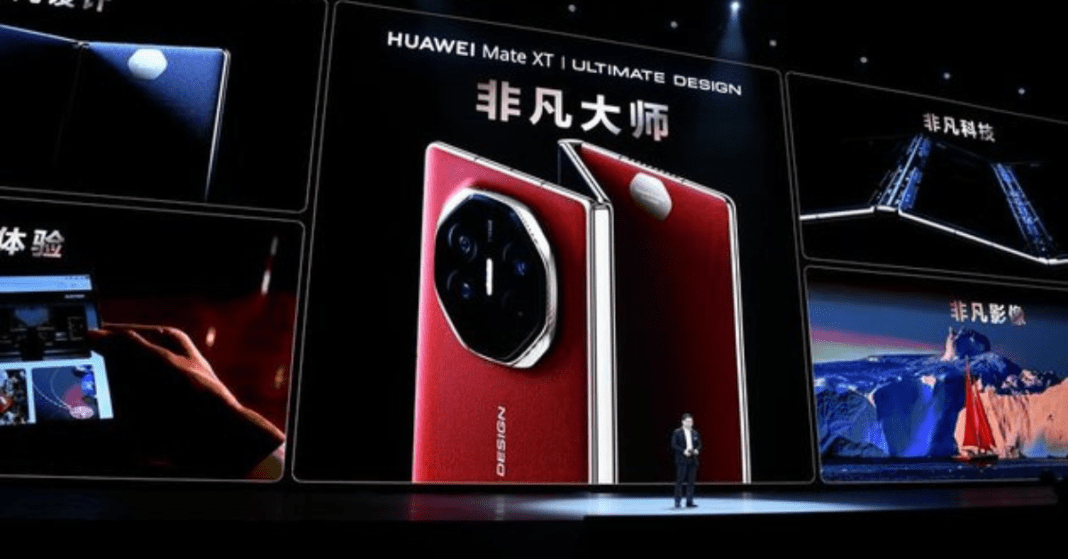In the ever-evolving smartphone market, competition continues to drive innovation. Huawei’s latest move—launching its $2,800 Mate XT trifold smartphone just hours after Apple debuted the iPhone 16—has grabbed global attention. The timing of these releases on September 20th positions both brands at the forefront of the smartphone market, with tech enthusiasts and buyers eagerly anticipating their next-generation offerings.
Huawei’s $2,800 Mate XT: A Game-Changer in the Foldable Phone Market
![]()
Huawei’s new Mate XT smartphone isn’t just any device; it represents the company’s bold step into the premium foldable phone market. With a price starting at over $2,800, the trifold device is more expensive than Apple’s most high-end iPhone 16 model. The Mate XT’s high cost reflects the advanced technology that Huawei has poured into the device, making it a top contender for high-end tech buyers.
The Mate XT boasts a 10.2-inch screen, making it one of the largest displays on a smartphone when unfolded. The display offers users a multi-screen experience, allowing them to view content on one, two, or three screens simultaneously. The phone’s thickness—only 3.6 millimeters when unfolded—gives it a sleek and cutting-edge profile, while its battery measures just 1.9 millimeters thick, showcasing Huawei’s commitment to innovation in both design and functionality.
Artificial Intelligence: The Mate XT vs. iPhone 16
Artificial Intelligence (AI) is a focal point in both Huawei’s and Apple’s latest releases. Huawei’s Mate XT includes impressive AI features, such as text translation and cloud-based content generation. These capabilities aim to enhance user experience, making the Mate XT more than just a smartphone—it’s a device equipped to handle complex tasks efficiently. This innovation comes after five years of development, as highlighted by Richard Yu, Huawei’s executive director, during the product launch event.
Apple’s iPhone 16, on the other hand, integrates AI features within its ecosystem through the upcoming release of Apple Intelligence AI, available via a free software update. Users of the iPhone 16 and previous models, including the iPhone 15 Pro and Pro Max, will be able to utilize these new AI functions. However, the extent of Apple’s AI integration into its hardware lags behind Huawei’s focus on more specific and enhanced AI-powered features.
Design and Functionality: Trifold vs. Traditional

One of the key differentiators between the Mate XT and the iPhone 16 is design. While Apple has consistently followed the conventional smartphone structure, Huawei has embraced the foldable phone trend, creating a device with unique versatility. The Mate XT’s trifold display sets it apart in a sea of slab-style smartphones. It provides users with more screen space and added functionality, making it appealing to professionals who rely on multi-tasking or those who enjoy a more immersive viewing experience.
Huawei’s Mate XT also comes with a foldable keyboard, pushing the boundaries of smartphone productivity tools. Apple, while a leader in innovation in many areas, has yet to delve into foldable smartphone technology, leaving a gap that Huawei seems eager to fill.
Market Positioning: Huawei’s Resurgence After U.S. Sanctions
Huawei’s launch of the Mate XT is not just about creating a premium smartphone—it’s a statement of resilience. The company has been navigating significant challenges since the U.S. imposed sanctions on it in 2019. These sanctions cut off Huawei’s access to critical technologies, including advanced chips, forcing the company to pivot and focus on developing homegrown solutions.
Despite these hurdles, Huawei has made significant strides. In August 2023, the company launched the Mate 60 Pro, a phone with a 7-nanometer chip developed by the Chinese chipmaker SMIC. This was seen as a significant technological breakthrough for Huawei, and it helped the brand gain momentum in its domestic market.
Richard Yu emphasized the company’s persistence in the face of adversity, noting during the Mate XT launch event that Huawei went through four rounds of sanctions but refused to give up. The company’s comeback is now fully underway, and the Mate XT’s debut is a major milestone in this journey.
Apple’s iPhone 16 Series: A New Chip and Advanced Features

On the other hand, Apple’s iPhone 16 launch marks another chapter in the company’s steady domination of the smartphone market. Apple announced that its new A18 chip, developed using highly advanced 3-nanometer technology, will power the iPhone 16. This chip promises to make the device significantly faster than its predecessors, including the iPhone 12.
Apple’s emphasis on speed and performance reflects its focus on maintaining an edge in a highly competitive market. However, while the iPhone 16 series offers faster speeds and enhanced AI capabilities, it doesn’t push the boundaries of smartphone design like Huawei’s Mate XT.
Consumer Demand: Pre-Order Numbers and Market Expectations
Huawei’s Mate XT seems to have struck a chord with consumers, particularly in China. By midday on the day of the launch, more than 3.5 million people had pre-ordered the device. By the end of the launch event, pre-orders had surpassed 4 million. These figures highlight the anticipation surrounding Huawei’s latest product and signal a potential resurgence in its global smartphone market share.
While Apple continues to dominate the U.S. market, it faces increased competition in China. According to Canalys, Huawei ranked fourth in smartphone market share in China during the second quarter of 2024, shipping 10.6 million smartphones. Apple, on the other hand, dropped out of the top five, with 10 million phones shipped in the first quarter of 2024. Huawei’s steady climb in its home market, combined with Apple’s dip, underscores the shifting dynamics in the global smartphone industry.
Future Outlook: Foldable Phones and Market Trends
The release of Huawei’s Mate XT signals a growing interest in foldable smartphones, a market segment that is still in its early stages but holds significant potential. Huawei is not alone in this endeavor—other Chinese smartphone makers have also entered the foldable and flip phone market, creating increased competition. Apple has yet to expand into this space, leaving room for companies like Huawei to innovate and capture market share.
The Mate XT’s release, coupled with Apple’s iPhone 16, highlights the divergent paths these two tech giants are taking. Huawei is pushing boundaries with foldable technology, while Apple remains focused on refining its established formula. This contrast may ultimately shape consumer preferences and the trajectory of the global smartphone market in the coming years.
Conclusion: A Battle of Innovation and Strategy
Huawei’s Mate XT trifold smartphone launch and Apple’s iPhone 16 release mark a significant moment in the ongoing battle for smartphone dominance. With the Mate XT’s cutting-edge foldable design and advanced AI features, Huawei is positioning itself as a serious contender in the premium smartphone market. Apple, with its new A18 chip and refined user experience, continues to be a leader in the industry, though its reluctance to enter the foldable space may give competitors an edge.
As both companies prepare for in-store sales on September 20th, the coming months will reveal how consumers respond to these devices. Whether the future lies in foldable smartphones or more traditional designs, one thing is clear—innovation remains at the heart of the smartphone industry’s evolution.






